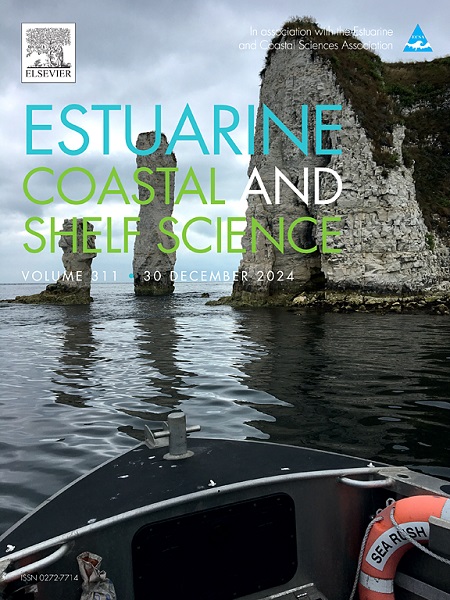越南北部金河和南三河口溶解相和颗粒相的稀土元素和钕同位素
IF 2.6
3区 地球科学
Q1 MARINE & FRESHWATER BIOLOGY
引用次数: 0
摘要
在越南北部的金南特里河口测量了溶解态和颗粒态稀土元素(REE),以追踪陆地向海洋的输入和颗粒-溶解相的相互作用。本文讨论了19个样品的稀土元素测量方法,该方法基于三相(溶解、不稳定和难熔)分析。溶解REE (dREE)浓度范围为1.16 ~ 14.7 nmol/kg,而颗粒REE (pREE,包括不稳定组分和难熔组分)浓度范围为24.6 ~ 104.6 nmol/kg。在固相中,轻稀土(LREE)含量最多(占总REE含量的85%),其次是中稀土(MREE),重稀土(HREE)含量不足15%。计算出的Ce、Eu和Gd的异常表明分馏最小。令人惊讶的是,在这个河口没有检测到明显的人为Gd痕迹。钕同位素组成分析表明,粒子从中游向河口输运过程中,同位素信号没有变化。溶出值和不稳定值的同位素特征(εNd = - 10.9±0.3)比难溶部分(εNd = - 12.5±0.4)更具有放射性。本文章由计算机程序翻译,如有差异,请以英文原文为准。

Rare earth elements and neodymium isotopes in dissolved and particulate phases in the Cam River andNam Trieu Estuary, north Vietnam
Dissolved and particulate rare earth elements (REE) were measured in the Cam-Nam Trieu estuary (north Vietnam) to trace land inputs to the ocean and particulate-dissolved phase interactions. This work discusses REE measurements in 19 samples based on the analysis of three phases (dissolved, labile, and refractory) using a quadrispike method. Dissolved REE (dREE) concentrations ranged from 1.16 to 14.7 nmol/kg, while particulate REE concentrations (pREE, including labile and refractory fractions) ranged from 24.6 to 104.6 nmol/kg. In the solid phase, light REEs (LREE) were most abundant (up to 85 % of total REE content), followed by middle REEs (MREE), with heavy REEs (HREE) representing less than 15 %. Calculated anomalies of Ce, Eu, and Gd indicated minimal fractionation. Surprisingly, no significant trace of anthropogenic Gd was detected in this estuary. Neodymium isotopic composition analysis revealed no change in isotopic signals during particle transport from the midstream part of the riverto the estuary. The isotopic signatures of the dissolved and labile values were more radiogenic ( = −10.9 ± 0.3) than those of the refractory fraction ( = −12.5 ± 0.4).
求助全文
通过发布文献求助,成功后即可免费获取论文全文。
去求助
来源期刊
CiteScore
5.60
自引率
7.10%
发文量
374
审稿时长
9 months
期刊介绍:
Estuarine, Coastal and Shelf Science is an international multidisciplinary journal devoted to the analysis of saline water phenomena ranging from the outer edge of the continental shelf to the upper limits of the tidal zone. The journal provides a unique forum, unifying the multidisciplinary approaches to the study of the oceanography of estuaries, coastal zones, and continental shelf seas. It features original research papers, review papers and short communications treating such disciplines as zoology, botany, geology, sedimentology, physical oceanography.

 求助内容:
求助内容: 应助结果提醒方式:
应助结果提醒方式:


